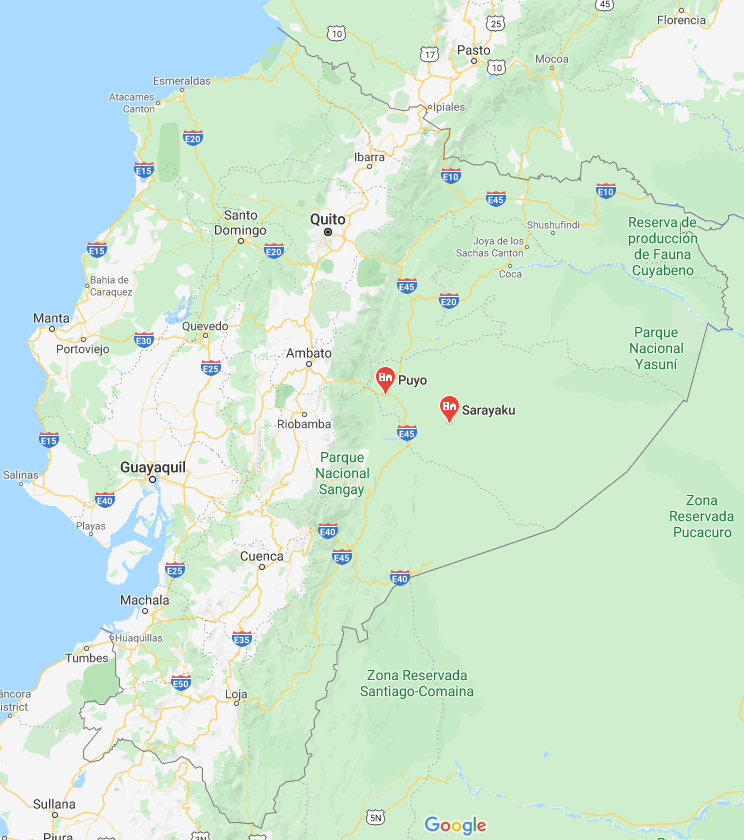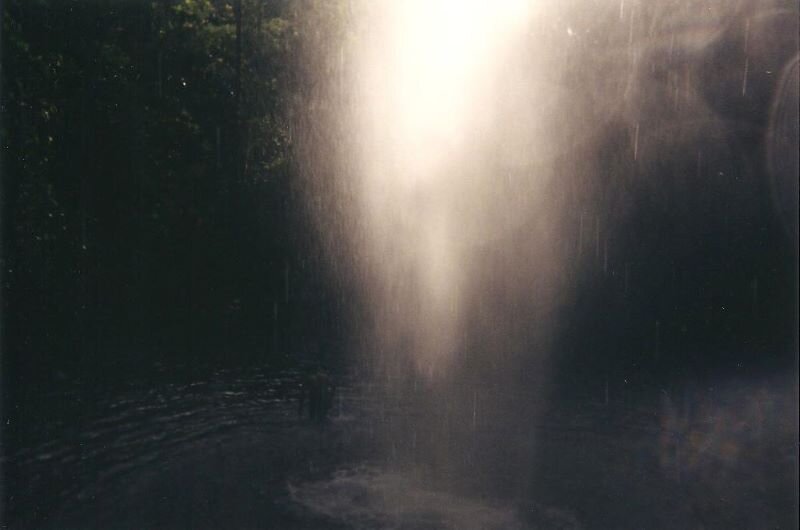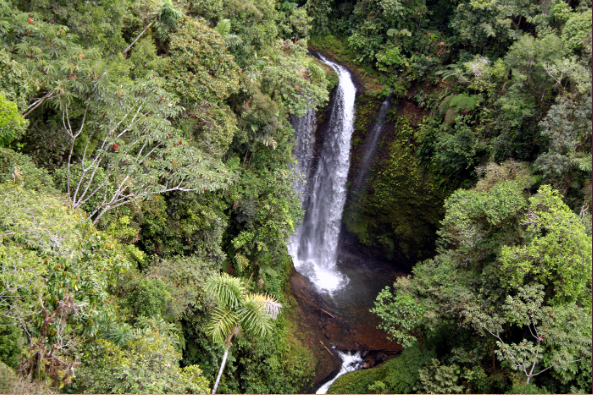This essay is the 5th of our monthly staff posts and is written by Outreach Coordinator Lisa DePaoli. It’s also the 15th installment in our What’s on your mind? blog. Enjoy!
In the summer of 2003, I went to Ecuador to do six weeks of preliminary research with the Sarayaku Kichwa (also spelled Quichua), one of 13 indigenous groups living there. I had contacts within the community, and they knew I was coming to Puyo, a town on the edge of the Oriente, the Amazonian region of Ecuador. Puyo is the nearest city to the Sarayaku territory; to reach their lands from there, you have to travel by a 25-minute plane ride or a day-long trip in a canoe. It is an autonomous region, which essentially means that they are self-governing, and they communally own their lands.
I am sharing their story because a similar situation is taking place right here in our own backyards, and because we can learn from it.


Source: Amazon Watch
The Sarayaku had been fighting oil exploration on their lands since 1996, but the Ecuadorian government had signed a contract with CGC, an Argentinian oil company, without the consent of the Sarayaku people, and the company was exploring for oil, using explosives and seismic testing, within their territory.
Sixty percent of Block 23, where the oil exploration was to take place, is on lands communally owned by the Sarayaku. Even though they are autonomous and hold extensive property, the government had asserted that it owns what lies beneath the surface. The first offer they received from the oil company was $10,000, which amounts to about $100 per person, which was, obviously, insulting and offensive. But the Sarayaku didn’t want their money. The company tried various other tactics to get the Sarayaku to agree to oil exploration, but it also reached out to other communities in the Block to try to get their consent, using the tactic of divide and conquer. In essence, they tried to buy their consent in return for jobs and financial help. (Sound familiar?)
The Sarayaku have always been adamantly against oil exploration. Part of the reason is their dependence on and relationship to their ancestral lands, but they have also learned from the experience of other indigenous groups in the northern Oriente of Ecuador. People there were promised jobs, a medical clinic, and a school, for example, and have been left with incredible amounts of devastation and public health impacts (along with a defunct medical clinic and school). Texaco, now Chevron, caused a “rainforest Chernobyl” there, depicted in film, print, and photo essay.
The Sarayaku developed a strategy to gain outside support for their cause through the internet and national and international human rights and legal organizations. They use the internet as a way to generate, sustain, and encourage interaction focused on gaining support, solving problems, and effecting social change. This organizing has helped them to avoid oil development and exert their identity through attachment to territory. They know that their future and the future of the ecosystem in which they live are tied to one another.
The story of Sarayaku resistance to oil exploration is very long – over 17 years. When I was there in 2003, CGC had advanced into their territory, bringing in explosives and machinery and doing seismic testing, and there were clashes between the Kichwa natives and the CGC workers. Gunshots had been fired, there had been kidnappings, threats were made, and there was a lot of tension in various places, including along the river, which is their means of travel. The Ecuadorian armed forces had become involved.
The Sarayaku community began to construct “Camps for Peace and Life” in the jungle, where CGC and armed forces had invaded their territory and put their way of living and lives at risk.
They were vilified for their actions: CGC officials called them terrorists and criminals, and the Ecuadorian President referred to them as violent terrorists standing in the way of the nation’s development.
Ultimately, after a protracted battle, in July of 2012 the Inter-American Court of Human Rights found that the Ecuadorian state had failed to consult with the Sarayaku community prior to signing a contract with CGC, in accordance with international regulations. The government was also found responsible for human rights violations and failure to protect the people of Sarayaku whose lives were at risk during CGC operations.
The Sarayaku community’s campaign against CGC and the State of Ecuador is considered a milestone: a victory for environmental justice and human rights in Ecuador, after 17 years of grit, determination, and persistence.
A big part of the reason for their success is that they formed alliances and coalitions with other people and groups. They communicated and worked with these individuals and groups, and accomplished much more together than ever would have been possible to do by themselves.
A common chant (and song) that I’ve heard in Latin America during rallies and strikes is “¡El pueblo, unido, jamás será vencido!” (The people, united, will never be defeated!) It’s a beautiful song, and of course now I can’t get it out of my head.
In April of this year – once again, in the northern Oriente region of Ecuador – an estimated 15,000 barrels of crude oil gushed into two of its most important rivers following the rupture of two major oil pipelines. The spill has affected over 2,000 indigenous families and left an estimated 120,000 people without access to the river’s fresh water.
Though I am fond of Ecuador, and have concern for the place and people, I was born here and have lived here most of my life, so I am also attached to this place. Perhaps you’ve already realized this, but a very similar situation is taking place right here in our own backyards. However, unlike this group, we’re deluded by the carrot and stick offered by fossil fuel companies: they dangle the carrot of jobs while waving the stick of economic hardship or the lack of energy sources. They simultaneously offer us something while suggesting negative outcomes that could happen if we don’t buy into their narrative. Moreover, why are we okay with the destruction of our landscapes, waterways, air quality, and health? The real, often unaccounted for costs – “negative externalities,” in economic parlance – far outweigh the relatively few jobs they provide. Fossil fuel companies take a lot more from us than they give back. This is not only unsustainable; it’s foolish and downright dangerous. If we were the Sarayaku, we’d tell them to get off our lawn. Now.
In our defense, we have been lulled by the narrative that is spun by powerful companies and the corrupt politicians and others who are bought by them (maybe some of them are not actually corrupt, but they buy into the narrative too). We have to see and think beyond this, and we have to change the narrative. There *are other possibilities. Pulling together and working on our goals and vision is key. Restoring community bonds is also important, as is becoming more engaged and involved in politics and labor rights. Only recently have we begun to assert our value and capabilities, thanks in part to the Black Lives Matter movement. It doesn’t have to be this way. If we all work together, we can accomplish really amazing things! The people, united, will never be defeated!
Related links:
Environmental Justice Atlas: Sarayaku, Oil Extraction in Block 23
Sarayaku: a Journey into the Heart of the Resistance
Sarayaku people successfully defend their land against oil extraction, Ecuador, 1996-2012, from the Global Nonviolent Action Database
Meanwhile, Chevron is making life miserable for the lawyer who won a massive lawsuit in Ecuador against the company. (This article contains more on this story and on Chevron.)
From the NYT: At Home in the Jungle, Everything Is ‘Alive and Has a Spirit’: The photographer Misha Vallejo has been documenting the Sarayaku Kichwa for three years.
Official website of the Sarayaku
Sarayaku: In Defense of Territory Scroll down on the left of this page; it is an informative and interactive website
The living forest: the Amazonian tribespeople who sailed down the Seine – 9 minute, 30 second film about the Sarayaku with footage of the area, the arrival of the company and the military, and the building of a dugout canoe for their global organizing.

If you look closely at this photo, you can see Nelson Gualinga in the lower center-left of the photo. Many of the Gualingas are very active and well-known in the Sarayaku community. The waterfall was incredible, but it was so tall that I could not get it all in the photo. I will never forget seeing this waterfall or the experience. Below is an aerial view of the waterfall that I found online (sacredland.org).


